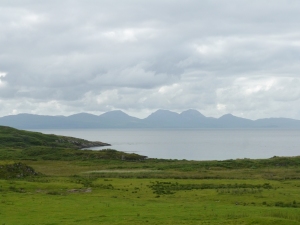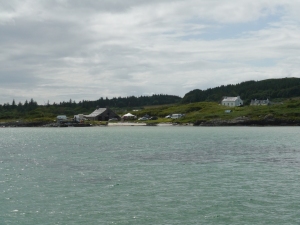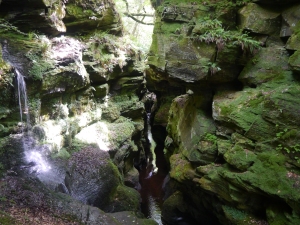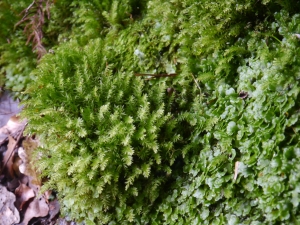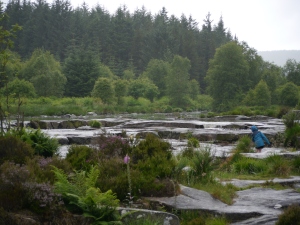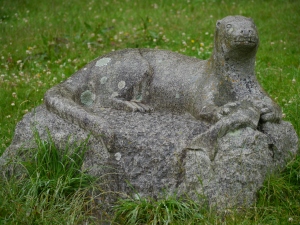Squealing, with delight I hope, both of them. Then a third joined in, above and behind. I sat watching the rising sun glisten the seas as a ferry made the trip back from Islay. I had the vantage point at the top of Achamore Gardens, jewel of Gigha’s crown. The buzzards played on the thermals, squealing as they went.
It was a first visit to Gigha, and certainly not the last. Three ferries took four bikes and a tent for a day away, as we hopped over Arran, reducing the driving time to get to Kintyre, enjoying the little drive that we did have with plenty of time to take in some glorious scenes along the way. The jagged ridge of Goatfell, which we see in the distance every clear day from home, towers above the pass to Lochranza.
There is common ground between Arran’s northern ferry port and the isle we sought. The yachties will like this. For Lochranza has a new pontoon, and Gigha is getting one. Construction is under way, with new moorings, reflective for night time arrivals, already in place.
The pontoon will be adjacent to the camping field, and the attraction for both campers and skippers alike is the wonderful Boathouse Café, where the chef does some amazing things with fresh-landed fare. His lamb is pretty special too.
Then a cycle along the island’s spine, gently, slowly, brings views all around. Those Paps of Jura took up much of the horizon again, but from the eastern side this time, with Islay in the foreground. Beyond, and before getting to Colonsay where we had been last week, the Corryvreckan churned, waiting on the unwary.
But to Achamore, a short cycle down the road. Thse gardens are truly majestic; rammed with prize-winning specimen trees and shrubs from around the globe, thriving in the temperate belt that holds Gigha in a spell, more sun and less than rain than the mainland just a short hop away. The law of sod applies and the pictures I’d intended were not to be, the batteries giving up after dutifully filling the honesty box for the family visit, with the spare back in the tent. So you’ll need to go online for more.
Gigha has a good tale to tell, from the standing stone of thousands of years before, to the start of Scotland’s Land Reform, with the community buy-out just a few years ago.
It is the community that now runs the hotel; and maintains those splendid gardens. There is no gardener at present and it is volunteer hours that strive to keep it in shape. What a task that is, for these gardens are worth the trip to the island alone. Mind you so’s the food at the Boathouse, much of it island grown or reared. There’s two reasons, before we even think of the scenery, the peace and the calming on the soul. Go on, you know you want to.

